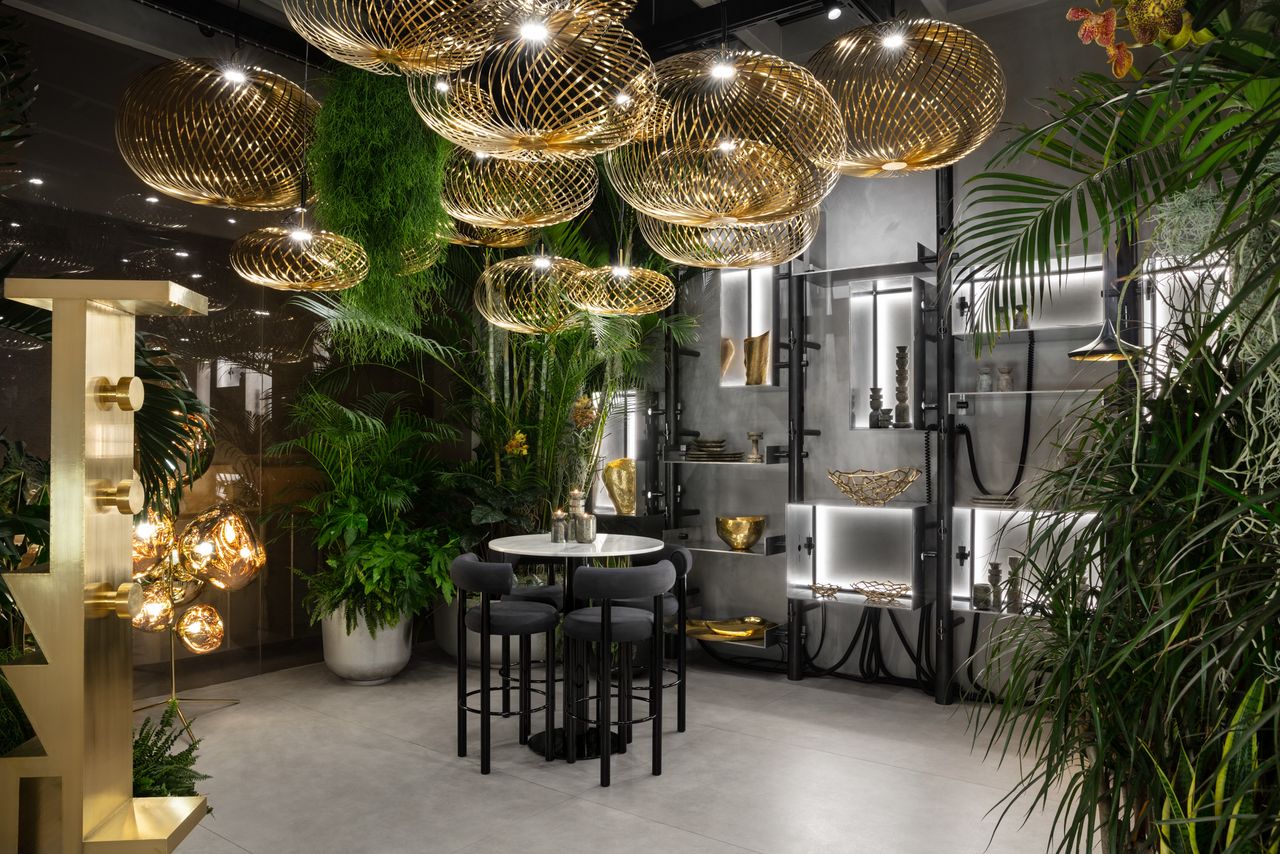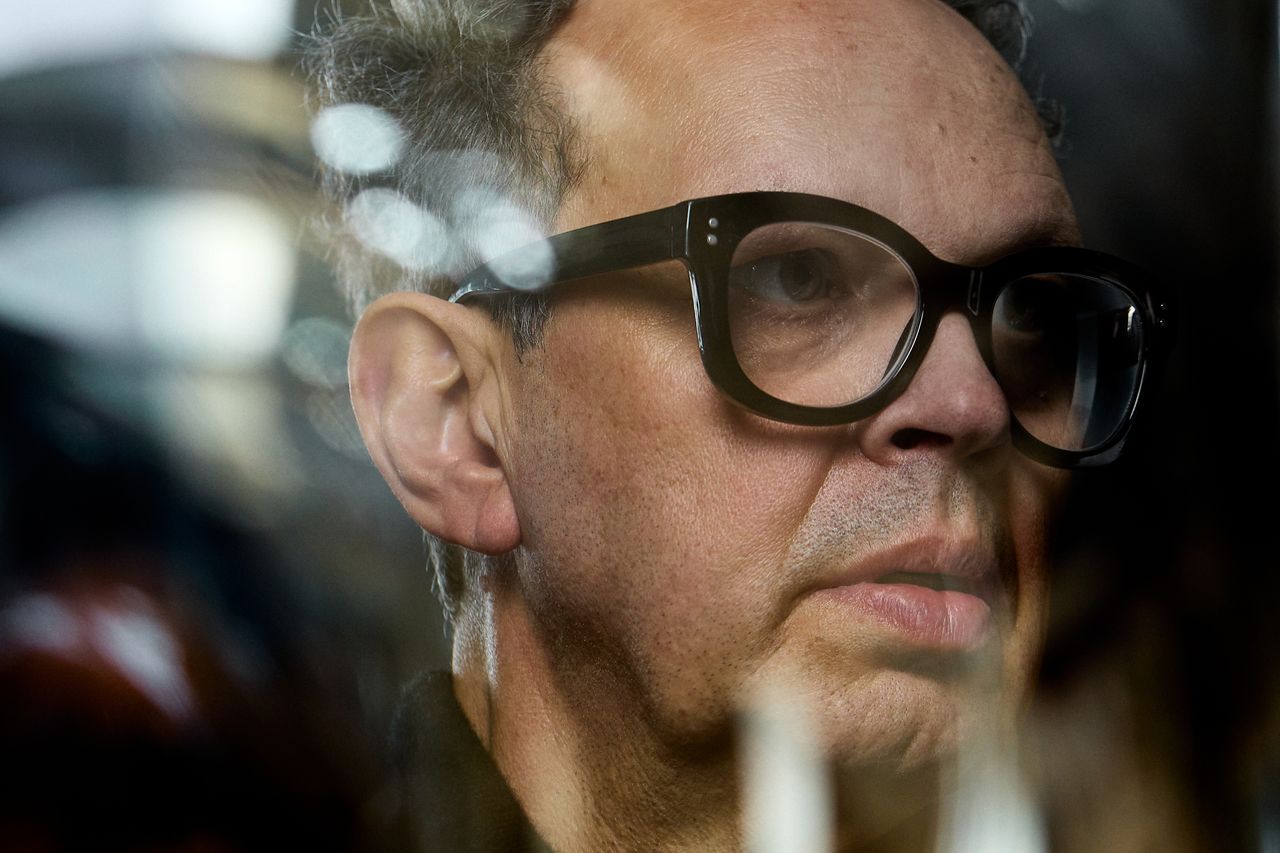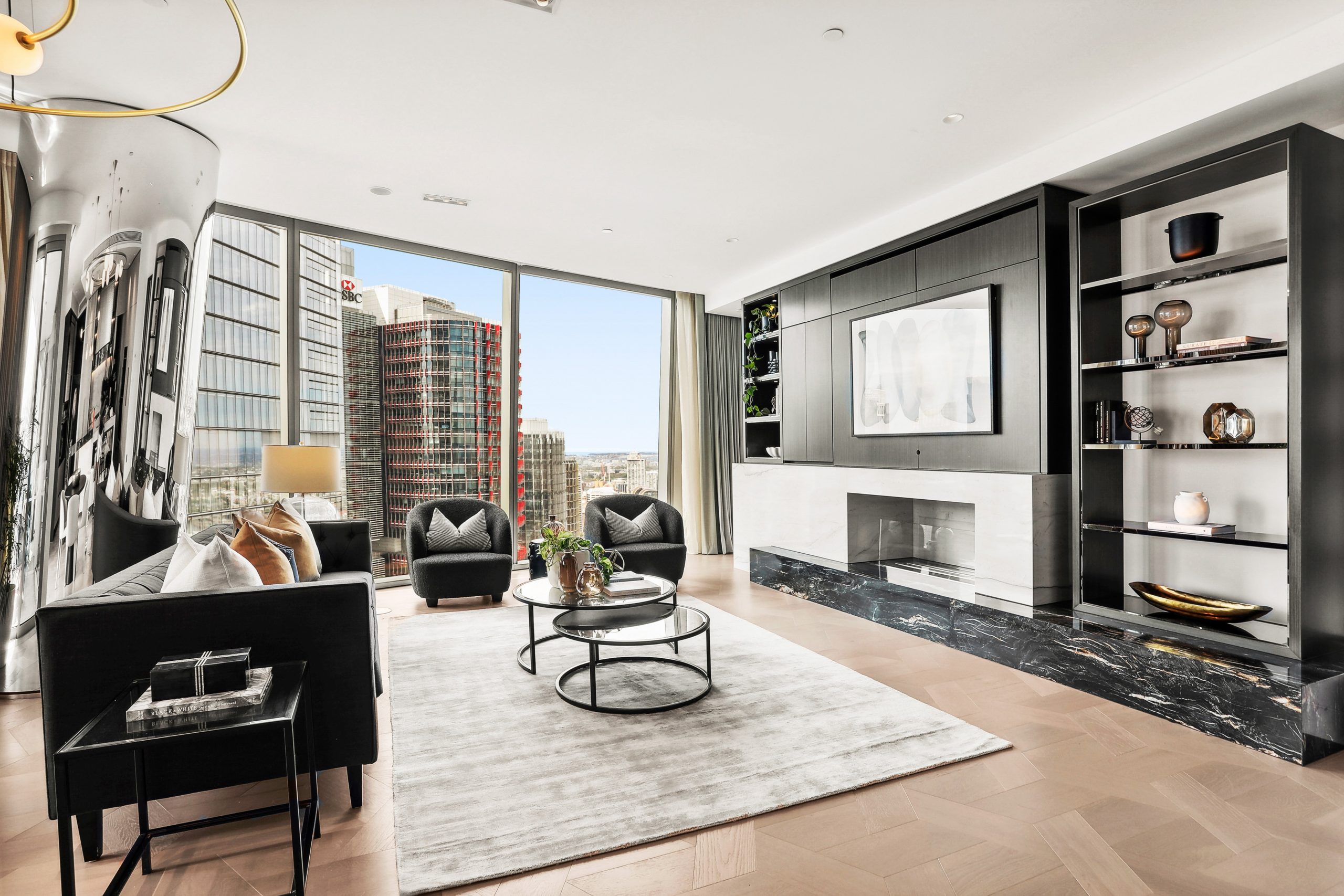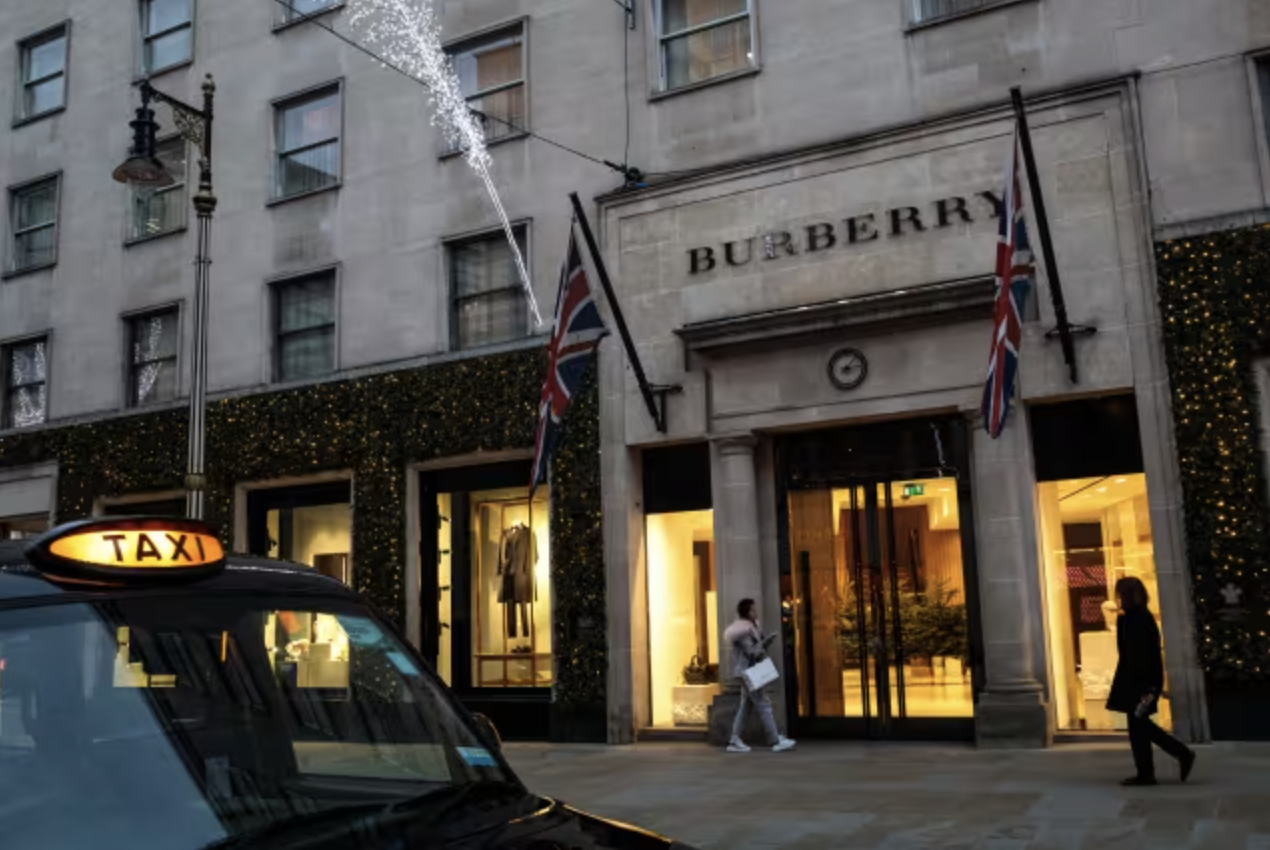20 Minutes With: Lighting and Furniture Designer Tom Dixon
British designer Tom Dixon can’t be put into one box when it comes to product design. He is multi-talented, and widely recognised for his sci-fi lighting designs—many of which look like sculptures hanging from the ceiling—but that’s not where his talents end.
He also designs furniture, including lamps, chairs, and tables meant to brighten up drab interiors, often with a disco flair.
This year, Dixon celebrates 20 years of his namesake brand. Over the last two decades his brand has expanded to 90 countries, with showrooms in New York, Tokyo, and Hong Kong. The latest boutique opened in Beijing in 2020.
Dixon has won numerous awards, including the London Design Medal at the London Design Festival. In 2014, he received an Order of the British Empire from Her Majesty the Queen.
Dixon was born in 1959 in Sfax, Tunisia, as the son of an English teacher and a journalist for the BBC World Service. In 1972, he began studying art at Holland Park Comprehensive high school in London, specializing in pottery and life drawing, and in 1979, he began working creative odd jobs (one was painting at a cartoon film company, another was playing in a disco band called Funkapolitan).
The rise of punk in London at the time helped create space for the kind of freeform design ethos that Dixon adopted. It gave his generation “license to create—without certificates, university courses or parental approval,” he says. In 1983, he learned how to weld with the help of a friend who worked in an automotive shop. He made over 100 chairs by hand in his first year.

In 1986, Dixon designed the S-Chair, which became a hit with Italian manufacturers for its curvy, elegant design. “I have often been asked what the inspiration was behind the S-Chair, and, honestly, the only memory I have is of drawing a small doodle of a chicken and thinking that I could make a chair from it,” he laughs.
Today, Dixon’s studio is based in a 19th century factory called the Coal Office in King’s Cross. In June, he was the subject of a retrospective at the Salone del Mobile furniture fair in Milan this June.
From his second home on the south coast of England, Dixon, 63, spoke to Penta about his brand, fashion inspiration, and the future of sustainable design.
PENTA: Can you believe it has been 20 years?
Tom Dixon: I can’t believe it’s true. I’ve been doing this longer than 20 years, but it’s 20 years since this label. It’s ridiculous. When I started it, it was after working for Italian luxury companies, working in the corporate world at Habitat (which is the equivalent of Pottery Barn in the U.S.) as creative director, it was time for me to do my own thing again. I wanted to mimic how fashion designers operate—design but also take care of their distribution and communication, and they have their name over the door, too. As a rule, product designers typically work for other brands. I wanted to have a singular voice and hold my aesthetic ideas together under one roof.
What fashion designers have you looked up to?
I love the Japanese brands that came out of the 1980s, like Commes des Garcons and Issey Miyake, in terms of keeping a sense of integrity. I love Raf Simons’ own label, too. There are young English designers at the moment too, like Grace Wales Bonner.
Who are your design heroes?
I was fortunate to have met the living design legends of the 1950s and 1960s before they passed away. Designers like Ettore Sottsass, Achille Castiglioni, Verner Panton, and Enzo Mari, who for me really are amazing examples who really believed in design as a way of changing the world. It was postwar Europe. When I first started, I was mainly interested in sculpture and only learned about design after I fell into it.
What was Ettore Sottsass from the Memphis Group like?
Calm, friendly, and unassuming. He was great. There were also designers I was inspired to rebel against. I thought postmodernism was the ugliest thing, very pastel, geometric and patterned. Meanwhile I was making things out of rusty metal. I’ve grown to love the Memphis Group—Ettore was not only a prolific designer, but he organized a whole movement. He has that polymath attitude, like Buckminster Fuller or Isamu Noguchi.
What was your approach for The Manzoni (restaurant and showroom) in Milan? It’s like a concrete metal jungle with an abundance of lights.
It was an attempt to try to challenge the idea of having conventional showrooms. I’ve been interested in food for a long time, there’s a link between entertaining and design, in general. We managed to get our restaurant The Coal Office going well in King’s Cross, so we brought something to Italy.
My time in Italy was often tied around food, as meetings with manufacturers were based around lunchtime at their factory, many of which have canteens. I thought it would be better to spend the money on a restaurant with a small showroom attached. Rather than someone entering a design showroom every 20 years to buy a designer table, they might come every two weeks to have lunch and eat off our plates and drink from our glasses. It’s a way to engage people than to have a dusty old furniture store.
What’s next for you?
My core interest remains the same. I love manufacturing techniques, materials, whether it’s industry or craft, we have a close relationship with the people who make the pieces. We have to be conscious and aware of our impact on the planet.
There are a few experiments in thinking through what sustainability looks like for a furniture company and how we can be more thoughtful about what we put into the world. That’s what our future is rotating around. We have to constantly rethink what we’ve done and how to pave the way for the future.
What is your approach to sustainable design?
Sustainability isn’t a single thing, it’s a huge host of actions. The most sustainable thing would be not to make anything at all. There’s a seaside plant called eel grass, which is collected in Denmark to create roofing material, and we’re experimenting with it as an upholstery material. Like many other people, we’re experimenting with mycelium, a type of fungi to make furniture. We’re also doing a conceptual project where we’re growing chairs underwater.
Reprinted by permission of Penta. Copyright 2021 Dow Jones & Company. Inc. All Rights Reserved Worldwide. Original date of publication: Aug 1, 2022.
 Copyright 2020, Dow Jones & Company, Inc. All Rights Reserved Worldwide. LEARN MORE
Copyright 2020, Dow Jones & Company, Inc. All Rights Reserved Worldwide. LEARN MORE
This stylish family home combines a classic palette and finishes with a flexible floorplan
Just 55 minutes from Sydney, make this your creative getaway located in the majestic Hawkesbury region.
As Paris makes its final preparations for the Olympic games, its residents are busy with their own—packing their suitcases, confirming their reservations, and getting out of town.
Worried about the hordes of crowds and overall chaos the Olympics could bring, Parisians are fleeing the city in droves and inundating resort cities around the country. Hotels and holiday rentals in some of France’s most popular vacation destinations—from the French Riviera in the south to the beaches of Normandy in the north—say they are expecting massive crowds this year in advance of the Olympics. The games will run from July 26-Aug. 1.
“It’s already a major holiday season for us, and beyond that, we have the Olympics,” says Stéphane Personeni, general manager of the Lily of the Valley hotel in Saint Tropez. “People began booking early this year.”
Personeni’s hotel typically has no issues filling its rooms each summer—by May of each year, the luxury hotel typically finds itself completely booked out for the months of July and August. But this year, the 53-room hotel began filling up for summer reservations in February.
“We told our regular guests that everything—hotels, apartments, villas—are going to be hard to find this summer,” Personeni says. His neighbours around Saint Tropez say they’re similarly booked up.
As of March, the online marketplace Gens de Confiance (“Trusted People”), saw a 50% increase in reservations from Parisians seeking vacation rentals outside the capital during the Olympics.
Already, August is a popular vacation time for the French. With a minimum of five weeks of vacation mandated by law, many decide to take the entire month off, renting out villas in beachside destinations for longer periods.
But beyond the typical August travel, the Olympics are having a real impact, says Bertille Marchal, a spokesperson for Gens de Confiance.
“We’ve seen nearly three times more reservations for the dates of the Olympics than the following two weeks,” Marchal says. “The increase is definitely linked to the Olympic Games.”

Getty Images
According to the site, the most sought-out vacation destinations are Morbihan and Loire-Atlantique, a seaside region in the northwest; le Var, a coastal area within the southeast of France along the Côte d’Azur; and the island of Corsica in the Mediterranean.
Meanwhile, the Olympics haven’t necessarily been a boon to foreign tourism in the country. Many tourists who might have otherwise come to France are avoiding it this year in favour of other European capitals. In Paris, demand for stays at high-end hotels has collapsed, with bookings down 50% in July compared to last year, according to UMIH Prestige, which represents hotels charging at least €800 ($865) a night for rooms.
Earlier this year, high-end restaurants and concierges said the Olympics might even be an opportunity to score a hard-get-seat at the city’s fine dining.
In the Occitanie region in southwest France, the overall number of reservations this summer hasn’t changed much from last year, says Vincent Gare, president of the regional tourism committee there.
“But looking further at the numbers, we do see an increase in the clientele coming from the Paris region,” Gare told Le Figaro, noting that the increase in reservations has fallen directly on the dates of the Olympic games.
Michel Barré, a retiree living in Paris’s Le Marais neighbourhood, is one of those opting for the beach rather than the opening ceremony. In January, he booked a stay in Normandy for two weeks.
“Even though it’s a major European capital, Paris is still a small city—it’s a massive effort to host all of these events,” Barré says. “The Olympics are going to be a mess.”
More than anything, he just wants some calm after an event-filled summer in Paris, which just before the Olympics experienced the drama of a snap election called by Macron.
“It’s been a hectic summer here,” he says.

AFP via Getty Images
Parisians—Barré included—feel that the city, by over-catering to its tourists, is driving out many residents.
Parts of the Seine—usually one of the most popular summertime hangout spots —have been closed off for weeks as the city installs bleachers and Olympics signage. In certain neighbourhoods, residents will need to scan a QR code with police to access their own apartments. And from the Olympics to Sept. 8, Paris is nearly doubling the price of transit tickets from €2.15 to €4 per ride.
The city’s clear willingness to capitalise on its tourists has motivated some residents to do the same. In March, the number of active Airbnb listings in Paris reached an all-time high as hosts rushed to list their apartments. Listings grew 40% from the same time last year, according to the company.
With their regular clients taking off, Parisian restaurants and merchants are complaining that business is down.
“Are there any Parisians left in Paris?” Alaine Fontaine, president of the restaurant industry association, told the radio station Franceinfo on Sunday. “For the last three weeks, there haven’t been any here.”
Still, for all the talk of those leaving, there are plenty who have decided to stick around.
Jay Swanson, an American expat and YouTuber, can’t imagine leaving during the Olympics—he secured his tickets to see ping pong and volleyball last year. He’s also less concerned about the crowds and road closures than others, having just put together a series of videos explaining how to navigate Paris during the games.
“It’s been 100 years since the Games came to Paris; when else will we get a chance to host the world like this?” Swanson says. “So many Parisians are leaving and tourism is down, so not only will it be quiet but the only people left will be here for a party.”
This stylish family home combines a classic palette and finishes with a flexible floorplan
Just 55 minutes from Sydney, make this your creative getaway located in the majestic Hawkesbury region.






















